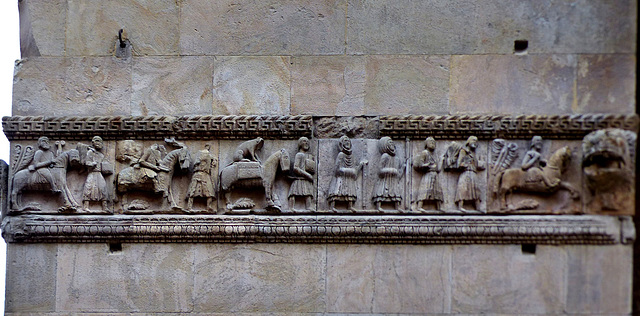Fidenza - Cattedrale di San Donnino
Fidenza - Cattedrale di San Donnino
Donjon du Plessis-Macé
Vigolo Marchese - San Giovanni
Castell'Arquato - Palazzo del Podestà
Parma - Duomo di Parma
Parma - Duomo di Parma
Castello di Canossa
Modena - Duomo di Modena
Modena - Duomo di Modena
Modena - Duomo di Modena
Nivelles - Collégiale Sainte-Gertrude
Ruines du château de Champtocé
Italie/ Italy/Italia : Il duomo e la Torre
Vintage 120 Camera. St Michael's Church, Guiting P…
Château de Champtocé
Croix de chemin sur la route de Champtocé
Château de Ranrouët
Saint-Sulpice-le-Guérétois, 23000, Creuse
Château de Ranrouët
Laon - Cathédrale Notre-Dame
Provins - Hôtel-Dieu
Provins - Tour César
Château d'Oudon
Abbaye de la Grainetière
Abbaye de la Grainetière - La salle Capitulaire
Château de Tiffauges
Château de Pouzauges
Château de Tiffauges
Le châtelet et le donjon de Tiffauges
Ferrara - Cattedrale di San Giorgio
Manoir de Launay
Manoir de Launay
Loro Ciuffenna - Pieve di San Pietro a Gropina
Loro Ciuffenna - Pieve di San Pietro a Gropina
Arezzo - Santa Maria della Pieve
Arezzo - Santa Maria della Pieve
Arezzo - Santa Maria della Pieve
Pienza - Pieve di Corsignano
Château du Rivau
Château de Clisson
Château de Clisson
Lizzano in Belvedere - San Mamante
Lizzano in Belvedere - San Mamante
Bologna - Le due torri
Location
Lat, Lng:
You can copy the above to your favourite mapping app.
Address: unknown
You can copy the above to your favourite mapping app.
Address: unknown
See also...
Keywords
Authorizations, license
-
Visible by: Everyone -
All rights reserved
-
275 visits
Fidenza - Cattedrale di San Donnino


In 1927, what is pretty recent, the city "Borgo San Donnino" changed it´s name to "Fidenza", as in Roman times it was known as "Fidentia Julia".
The city was named and the Duomo inside the walls was dedicated to San Donnino di Fidenza (aka "Domninus of Fidenza"), who was martyred nearby in 291.
Sigeric the Serious, Archbishop of Canterbury, made the pilgrimage to Rome following the Via Francigena around 990. His contemporary records of this journey still exist (and are source for the modern guide books). He reached "Sce Domnine" after 36 days, what is pretty fast for more than 1000kms.
The erection of the Cattedrale di San Donnino started in the 11th century, the first consecration took place in 1106, though the building process continued. From around 1200 on Master Benedetto Antelami and his workshop worked here, not only as Master masons. Antelami may as well be the architect of the facade.
Frederick Barbarossa had entrusted "Borgo San Donnino" to the Pallavicino family of Piacenza. In 1268 - after a siege - the city was conquered by the troops of Parma, who looted and burnt down it completely. All houses got destroyed at that time just the Duomo was saved, but it was not completed at that time. The building process came to a stop - and was never continued.
A legend tells, that when Charlemagne passed through "Borgo San Donnino", an angel told him, where to dig for San Donnino´s relics. He is connected to the city and the duomo. Seen here is Charlemagne´s entourage on their way back home. He had just chased away the Sarazens from Rome (another legend). It is known, that Charles owned an elephant, named Abul Abbas. Seen here is another member of the imperial menagerie. A tame cheetah on horseback.
The very left rider (next to the walking pilgrim) may be Charlemagne himself, as he carries a scepter.
The city was named and the Duomo inside the walls was dedicated to San Donnino di Fidenza (aka "Domninus of Fidenza"), who was martyred nearby in 291.
Sigeric the Serious, Archbishop of Canterbury, made the pilgrimage to Rome following the Via Francigena around 990. His contemporary records of this journey still exist (and are source for the modern guide books). He reached "Sce Domnine" after 36 days, what is pretty fast for more than 1000kms.
The erection of the Cattedrale di San Donnino started in the 11th century, the first consecration took place in 1106, though the building process continued. From around 1200 on Master Benedetto Antelami and his workshop worked here, not only as Master masons. Antelami may as well be the architect of the facade.
Frederick Barbarossa had entrusted "Borgo San Donnino" to the Pallavicino family of Piacenza. In 1268 - after a siege - the city was conquered by the troops of Parma, who looted and burnt down it completely. All houses got destroyed at that time just the Duomo was saved, but it was not completed at that time. The building process came to a stop - and was never continued.
A legend tells, that when Charlemagne passed through "Borgo San Donnino", an angel told him, where to dig for San Donnino´s relics. He is connected to the city and the duomo. Seen here is Charlemagne´s entourage on their way back home. He had just chased away the Sarazens from Rome (another legend). It is known, that Charles owned an elephant, named Abul Abbas. Seen here is another member of the imperial menagerie. A tame cheetah on horseback.
The very left rider (next to the walking pilgrim) may be Charlemagne himself, as he carries a scepter.
, Don Sutherland have particularly liked this photo
- Keyboard shortcuts:
Jump to top
RSS feed- Latest comments - Subscribe to the comment feeds of this photo
- ipernity © 2007-2025
- Help & Contact
|
Club news
|
About ipernity
|
History |
ipernity Club & Prices |
Guide of good conduct
Donate | Group guidelines | Privacy policy | Terms of use | Statutes | In memoria -
Facebook
Twitter

Historical & Architectural Gems
Your beautiful capture is greatly admired
Historical & Architectural Gems
Sign-in to write a comment.